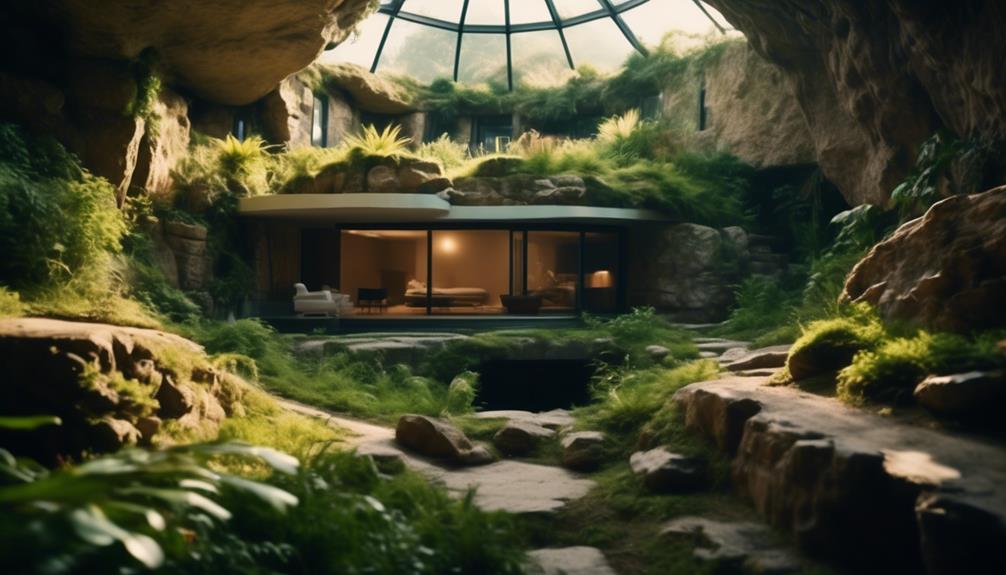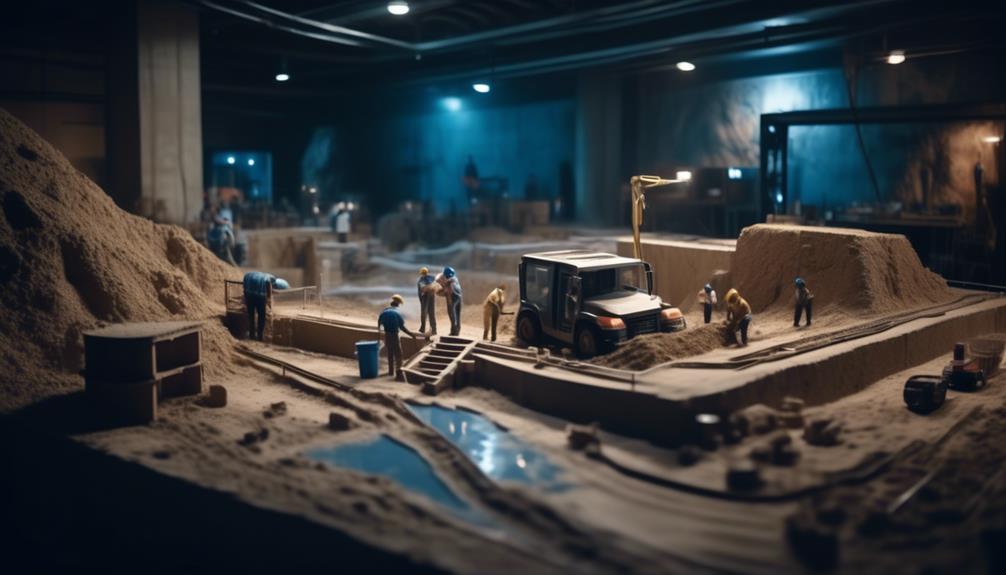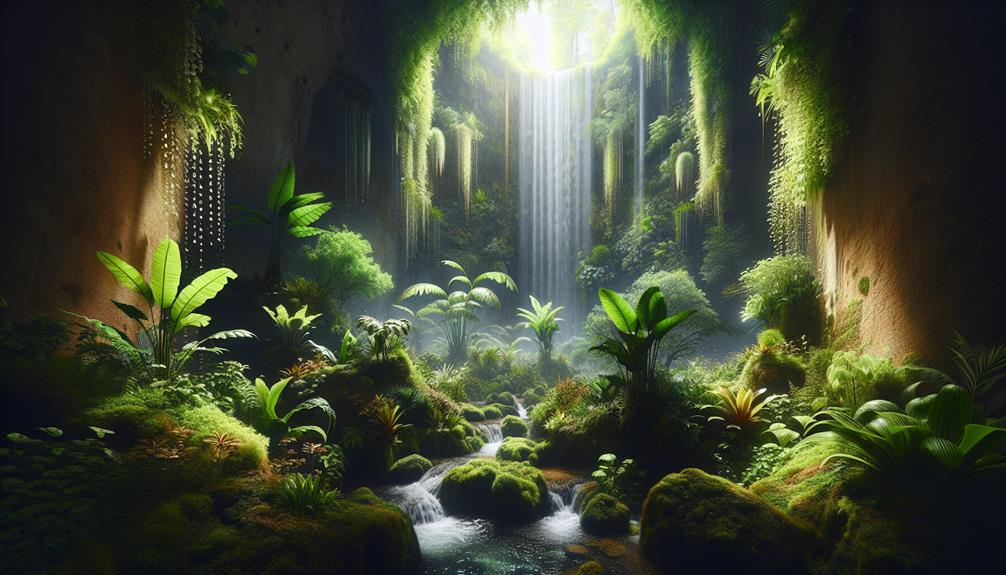Are you ready to dig deep and uncover the secrets of the underground revolution?
Like a hidden gem waiting to be unearthed, the world of underground homes offers a unique and innovative way to create your own oasis.
But what does it take to build your very own underground haven?
From the types of underground houses and construction materials used, to the advantages and challenges that come with this alternative way of living, this ultimate guide will take you on a thrilling journey of exploration and discovery.
So, if you're curious about how to maximize natural light, blend harmoniously into the landscape, and unleash the subterranean revolution, then hold on tight, because this is just the beginning.
Key Takeaways
- Underground homes, such as earth shelters and earth berm homes, offer energy efficiency, protection from severe weather, and natural noise control.
- Sustainable materials and efficient ventilation systems are essential in the construction of underground homes to create a healthy living environment.
- Underground homes provide advantages such as energy efficiency, reduced HVAC bills, protection from severe weather, low visibility, and a unique and sustainable living experience.
- Building underground homes comes with challenges such as adhering to building codes and safety standards, preventing mold, implementing effective ventilation systems, and ensuring structural integrity and safety.
Types of Underground Houses
When it comes to underground homes, there are two main types that you should know about: earth shelters and earth berm homes.
Earth shelters are built by excavating and shaping the land to create a protective structure that's partially or entirely covered with soil.
On the other hand, earth berm homes are built above ground and then covered with a layer of earth, blending into the natural landscape.
Both types of underground homes offer numerous advantages of underground living.
Firstly, they're highly energy efficient, providing natural insulation that reduces heating and cooling costs.
Secondly, they offer protection from severe weather and natural disasters, as the surrounding earth acts as a shield.
Additionally, underground homes require less upkeep compared to traditional homes, as they're naturally resistant to wear and tear.
Furthermore, the natural noise control provided by the earth's insulation creates a peaceful and quiet environment.
Construction Materials and Techniques
As you embark on the journey of constructing your own underground oasis, it's essential to explore the innovative construction materials and techniques that will bring your vision to life while ensuring environmental sustainability.
Sustainable building materials play a crucial role in underground home construction. Incorporating materials such as reclaimed wood, recycled steel, and bamboo flooring can reduce environmental impact while adding a touch of elegance.
Efficient ventilation systems are also of utmost importance to maintain a healthy living environment. Incorporating passive cooling techniques like earth tubes and geothermal heat pumps can help regulate temperature and air quality.
Additionally, utilizing smart home technology can optimize energy usage and reduce carbon footprint.
Advantages of Underground Homes

Immerse yourself in a world of environmental sustainability and innovative design as you discover the myriad advantages of creating your own underground oasis.
Explore the benefits of earth shelter homes and experience the following advantages:
- Energy Efficiency: Underground homes have natural insulation provided by the earth, helping to regulate indoor temperatures throughout the year. This reduces the need for heating and cooling systems, resulting in significant energy savings.
- Reduced HVAC Bills: With natural insulation and temperature regulation, underground homes require less reliance on HVAC systems. This translates to lower utility bills and a smaller carbon footprint.
- Protection from Severe Weather: Underground homes offer unparalleled protection from severe weather events such as hurricanes, tornadoes, and wildfires. The earth acts as a natural barrier, shielding you from external elements and providing a sense of security.
- Low Visibility and Blending into the Landscape: Underground homes have a low visual impact on the surrounding environment. By seamlessly blending with the natural landscape, these homes preserve the beauty of the surroundings while providing a unique and sustainable living experience.
Experience the advantages of underground living and embark on a journey towards a more environmentally conscious and innovative lifestyle.
Challenges and Solutions in Building
Embark on a journey of ingenuity and problem-solving as we explore the challenges and solutions in building your own underground oasis.
When it comes to creating an underground home, it's crucial to adhere to building codes and safety standards. These regulations ensure the structural integrity and safety of your underground dwelling.
Additionally, mold prevention and ventilation planning are critical aspects to consider. Proper ventilation helps maintain air quality and prevents the growth of mold, which can thrive in damp underground environments. By implementing effective ventilation systems and moisture control methods, you can create a healthy and comfortable living space.
It's essential to prioritize these challenges and find innovative solutions to ensure the success of your underground oasis.
Design and Construction Process

When embarking on the journey of designing and constructing your own underground oasis, careful planning and attention to detail are essential to create a sustainable and harmonious living space. To ensure the success of your project, consider the following key aspects of underground home architecture:
- Incorporating natural elements in design: Embrace the beauty of the surrounding landscape by seamlessly blending your underground home with nature. Utilize large windows and skylights strategically placed to maximize natural light and create a connection to the outdoors.
- Maximizing natural light and meeting building regulations: While underground homes may seem dim, innovative design techniques can bring ample light into the space. Work with architects and engineers to ensure your design meets all building regulations while still capitalizing on natural light sources.
- Planning considerations for underground homes: Underground construction requires careful planning to ensure structural integrity and proper functionality. Consider factors such as drainage, ventilation, and insulation to create a comfortable and sustainable living environment.
- Submitting for a building permit: Before starting construction, it's crucial to obtain the necessary permits and approvals from local authorities. Familiarize yourself with the building codes and regulations specific to underground homes to ensure compliance.
Building Permits and Getting Started
To kickstart the process of turning your underground oasis into a reality, it's crucial to navigate the realm of building permits and get your project off the ground.
Building an underground home requires careful consideration of design and construction, as well as adherence to local building codes and safety standards.
Before you begin, it's essential to obtain the necessary permits from your local authorities. These permits will ensure that your underground home design meets all the required regulations and guidelines.
Additionally, it's important to factor in cost considerations during this stage. Underground homes can be cost-effective in the long run due to their energy efficiency, but initial construction costs may be higher.
Frequently Asked Questions
Are There Any Restrictions or Regulations on Building Underground Homes in Certain Areas?
In certain areas, there may be building codes and regulations that you'll need to follow when constructing your underground home. These could include obtaining construction permits and ensuring structural integrity for safety and environmental considerations.
How Do Underground Homes Handle Waste Management, Such as Plumbing and Sewage?
When it comes to waste management in underground homes, you'll be amazed at the innovative solutions. From eco-friendly plumbing systems to efficient ventilation, underground homes prioritize sustainability and minimize environmental impact.
Can Underground Homes Have Windows or Skylights for Natural Lighting?
Yes, underground homes can have windows or skylights for natural lighting. Ventilation methods like air wells, light tubes, and atriums can be incorporated into the construction process to maximize natural light and airflow.
What Are the Potential Risks or Dangers Associated With Living in an Underground Home?
Living in an underground home has potential risks and dangers. Restrictions and regulations may complicate construction. Waste management, plumbing, and sewage systems require careful planning. Proper ventilation, windows, and skylights are essential for natural lighting and to prevent radon gas and carbon monoxide buildup.
How Do Underground Homes Handle Issues Such as Radon Gas and Carbon Monoxide Buildup?
To handle radon gas and carbon monoxide buildup, underground homes incorporate radon gas mitigation systems and efficient ventilation systems. These innovative methods ensure a safe and healthy living environment while embracing the benefits of living underground.
Conclusion
Congratulations! You're now equipped with the knowledge and inspiration to embark on the incredible journey of building your own underground oasis.
By embracing the subterranean revolution, you aren't only creating a unique and innovative living space, but also embracing the beauty and harmony of nature.
So, let your imagination run wild, mix the earth with creativity, and unlock the door to a world where boundaries fade and your dreams come to life.
Get ready to dig deep and unearth the extraordinary!

